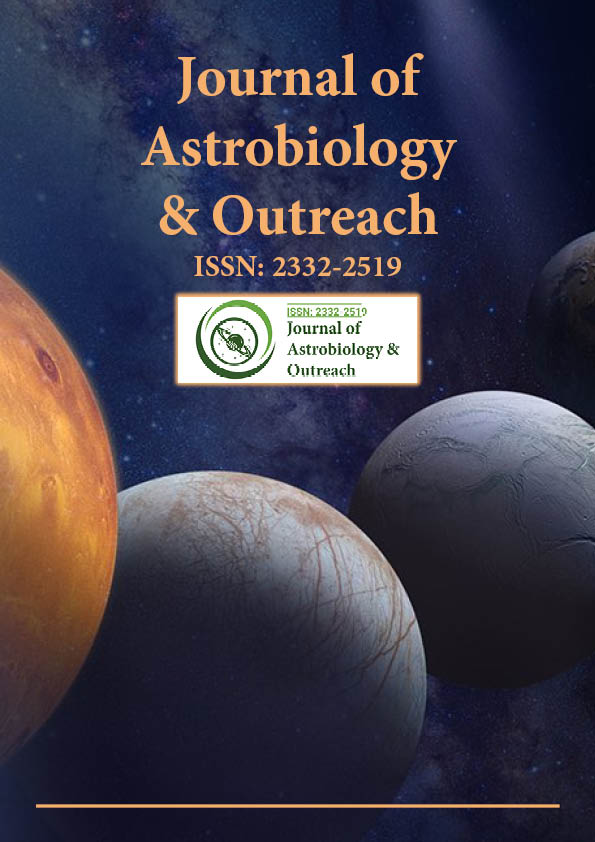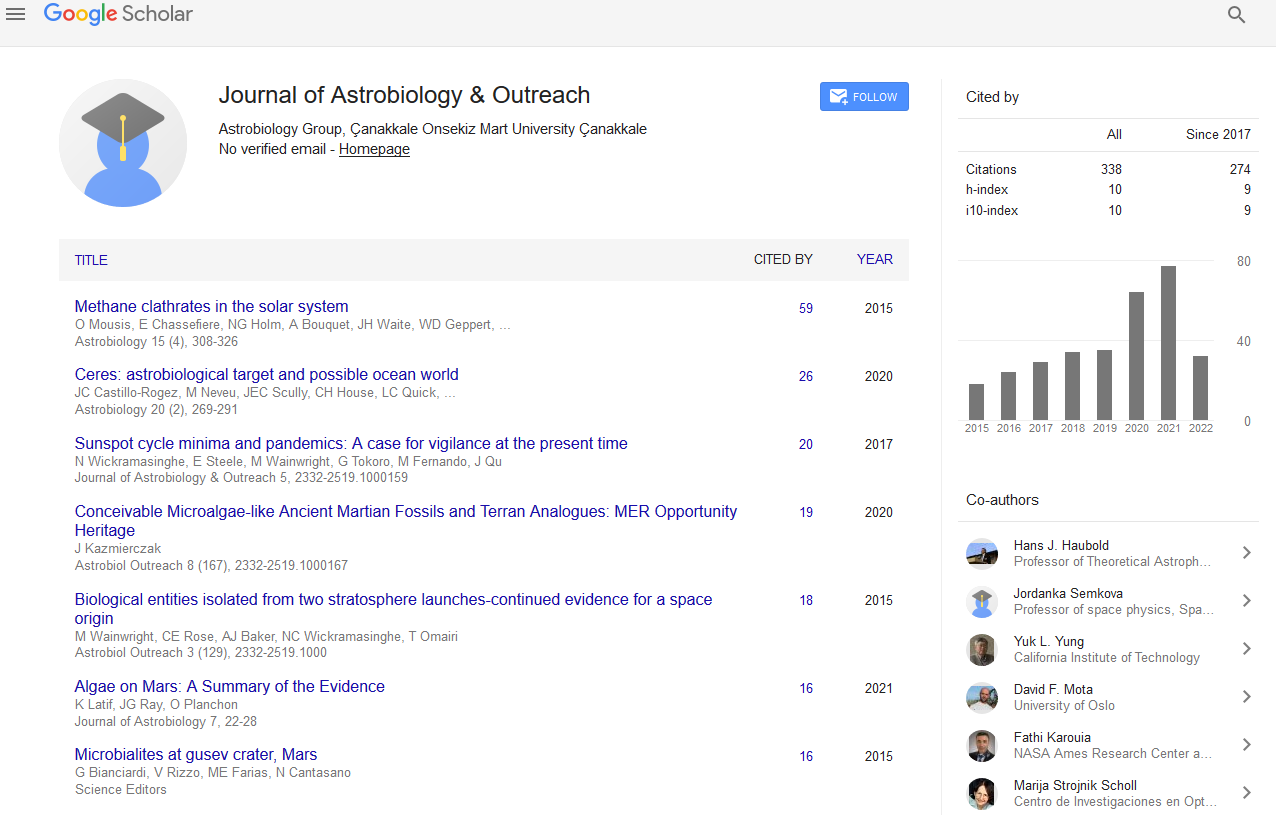Indexed In
- Open J Gate
- Academic Keys
- JournalTOCs
- RefSeek
- Hamdard University
- EBSCO A-Z
- OCLC- WorldCat
- Google Scholar
Useful Links
Share This Page
Journal Flyer

Open Access Journals
- Agri and Aquaculture
- Biochemistry
- Bioinformatics & Systems Biology
- Business & Management
- Chemistry
- Clinical Sciences
- Engineering
- Food & Nutrition
- General Science
- Genetics & Molecular Biology
- Immunology & Microbiology
- Medical Sciences
- Neuroscience & Psychology
- Nursing & Health Care
- Pharmaceutical Sciences
Opinion Article - (2023) Volume 11, Issue 3
Innovating Astrobiology: ABE/ASPIRE Mission Concepts and their Impact on Current Research
Phillips Petr*Received: 01-May-2023, Manuscript No. JAO-23-21763; Editor assigned: 03-May-2023, Pre QC No. JAO-23-21763 (PQ); Reviewed: 17-May-2023, QC No. JAO-23-21763; Revised: 24-May-2023, Manuscript No. JAO-23-21763 (R); Published: 31-May-2023, DOI: 10.35248/2332-2519.23.11.297
Description
The Astrobiology Explorer Mission Concepts, commonly known as ABE/ASPIRE, are innovative mission proposals developed by NASA to advance our understanding of astrobiology. Astrobiology Explorer (ABE) and Astrophysics Stratospheric Planetary Investigations and Research (ASPIRE) aim to explore the origins and potential for life beyond Earth. This commentary delves into the exciting mission concepts of ABE/ ASPIRE, highlighting their objectives, scientific instruments, and their potential to revolutionize our knowledge of the universe.
Exploring the origins of life
ABE/ASPIRE missions have a primary focus on studying the origins of life and the conditions necessary for its emergence. By investigating the chemical composition of planetary systems and the environments that foster life, these missions aim to unravel the mysteries of life's origins. ABE utilizes spectroscopy to analyze the infrared signatures of organic molecules and minerals on distant celestial bodies. This enables scientists to identify potential bio signatures and habitable environments, providing crucial insights into the possibility of life beyond earth.
ASPIRE, on the other hand, focuses on studying the atmospheres of exoplanets, searching for signs of habitability and the presence of key life-sustaining elements such as water vapor, methane, and oxygen. By observing exoplanetary atmospheres, ASPIRE aims to identify the conditions that could support life and provide vital information for future missions dedicated to the search for extraterrestrial life.
Cutting-edge scientific instruments
ABE/ASPIRE missions employ state-of-the-art scientific instruments to carry out their ambitious goals. ABE incorporates advanced infrared spectrometers and imaging spectrometers that can analyze the chemical compositions of objects in our solar system, such as asteroids, comets, and the moon. These instruments enable precise measurements of organic compounds, minerals, and other key elements relevant to astrobiology research.
Aspire on the other hand, employs the high-resolution of spectrographs and sensitive detectors to analyze the spectra of explanatory atmospheres. These instruments can detect and characterize atmospheric components, including trace gases, and determine their potential biological relevance. By studying the chemical makeup of explanatory atmospheres, ASPIRE aims to provide valuable insights into the potential habitability and presence of life-supporting conditions on distant worlds.
Revolutionizing astrobiology research
The ABE/ASPIRE missions have the potential to revolutionize astrobiology research by providing unprecedented data and insights into the conditions necessary for life to arise and exist beyond Earth. The detailed analysis of organic molecules, minerals, and atmospheric compositions will advance our understanding of the chemical processes that drive the emergence and evolution of life.
These mission concepts also have broader implications for space exploration and future missions. The data collected by ABE/ASPIRE will contribute to the selection and planning of future missions focused on the search for life, aiding in the identification of potential target locations and bio signatures to be explored more extensively.
Furthermore, the ABE/ASPIRE missions stimulate collaboration between different scientific disciplines, including astronomy, chemistry, geology, and planetary science. The integration of knowledge from these diverse fields enhances our understanding of the complex interplay between celestial bodies and the potential for habitability and life.
Conclusion
The Astrobiology Explorer Mission Concepts (ABE/ASPIRE) represent ground breaking initiatives to unravel the mysteries of life's origins and its existence beyond earth. These missions, equipped with cutting-edge scientific instruments, aim to provide invaluable insights into the chemical compositions of distant celestial bodies and explanatory atmospheres. By advancing our understanding of habitability and the potential for life, ABE/ASPIRE missions have the potential to change our perspective on the universe and guide future endeavors in the search for extraterrestrial life. The innovative researches conducted through ABE/ASPIRE will undoubtedly leave a lasting impact on the field of astrobiology and our quest to understand life's place in the cosmos.
Citation: Phillips Petr (2023) Innovating Astrobiology: ABE/ASPIRE Mission Concepts and their Impact on Current Research. J Astrobiol Outreach. 11:297.
Copyright: © 2023 Phillips Petr. This is an open-access article distributed under the terms of the Creative Commons Attribution License, which permits unrestricted use, distribution, and reproduction in any medium, provided the original author and source are credited.

